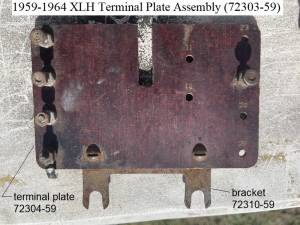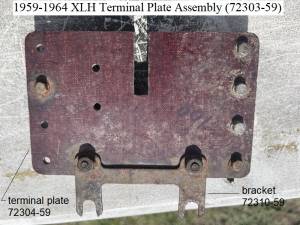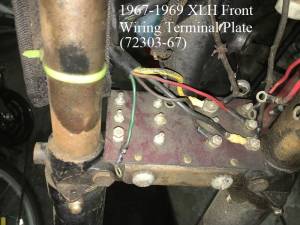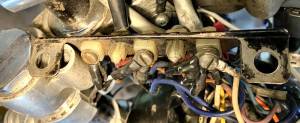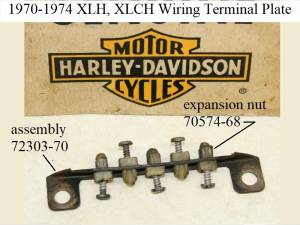Table of Contents
IH: Electrical System
Subdocuments
 Stock Sportster Main Wiring Harnesses / Part Numbers
Stock Sportster Main Wiring Harnesses / Part Numbers
 For illustrated OEM wiring schematic drawings - Goto this IH section.
For illustrated OEM wiring schematic drawings - Goto this IH section.
 For some simplified wiring diagrams/schematics - GoTo this REF section.
For some simplified wiring diagrams/schematics - GoTo this REF section.
Wiring
For electrical devices to function, they must have a completed circuit, from the supply to device and then back to the supply. The ironheads use a negative ground reference and distribute the positive voltage thru the wiring harness & switches. The following is a generalized description of the power and ground distribution. Some models may not have exactly the same wiring configuration, especially the earliest models.
Grounds
Ironheads did not include any wires in the wiring harness for centralizing the grounding of each devices. Even the EVO models up thru 1990 did not have ground wires in the harness. Instead, these models used the frame itself for grounding the various electrical devices, thereby completing their electrical circuit back to the source. For grounding the various devices on the forks, the triple tree was grounded to the frame thru the neck bearings. For the switches and devices on the isolated handlebars, there was a ground wire attached to one of the handlebar riser mounting bolts with the other end of the wire attached to the upper or lower triple tree bracket.
All (or most) of the electrical devices on such models were grounded thru their mounting brackets or wired to a bolt nearby onto the frame. Whether the power source was the battery, the regulator or the generator, it was grounded nearby on the frame directly or at the rear engine mount.
Power
The positive power source (battery/regulator) sends voltage thru a main circuit breaker or fuse wire to the keyswitch. The keyswitch then supplied power thru separate circuit breakers to either or both the Ignition circuit and the Lights circuit, each with multiple devices. The various electrical devices on these two circuits are supplied with power thru the wiring harness.
Some devices (like turn signal lights) get power only after it runs thru activated switches or other devices. In these cases, the end devices were constantly grounded but then activated by positive power. For other devices (like the coil & indicator lights) they receive power whenever the keyswitch sends power on that circuit. But they are only activated when a switch or device provides a ground path for that device. Later, the coil and ignition module were only supplied with power when the RUN/STOP switch was in RUN mode.
The turn signals operated from one flasher. The positive voltage output of the flasher was routed thru each handlebar TS switch before going to the appropriate lights (front, rear & indicator). These TS lights were grounded to the frame by their housing brackets.
Because there were no ground wires in the harness, it is VERY IMPORTANT that all mounting brackets for electrical devices make a good connection to the frame so that the device can be grounded and the electrical circuit can be completed back to the battery negative terminal. Paint, corrosion or the mount being loose could cause intermittent or no operation.
On the wiring diagram for such models, there is only one wire shown going to a device. This is typically the positive power wire. Sometimes the diagram showed the housing as grounded, but other times it did not show the device as grounded even though it was being grounded thru the housing. Where multi-functions occured within the same housing, such as the taillight/brake light, there are two wires shown running to that device, but both wires are bringing positive power for each individual function, with the ground for both functions going thru the device mounting bracket to the frame.
Main Wiring Terminals
- 1959-1964 XLH models have a 10 connection point terminal plate mounted between the forks on the tree.
- 1965-1966 XLH models have an 11 connection point terminal plate mounted between the forks.
The additional connection point was added to install a rectifier for the headlight. - 1967-1969 XLH models have a 12 connection point terminal plate mounted between the forks on the tree.
- 1970-1974 XLH and XLCH models have a 5 connection point terminal plate mounted between the forks on the tree.
The bracket holds nylon blocks into which screws are used as insulated terminal points for interconnection of wires.
Click on any pic below to enlarge:
Circuit Breakers
The circuit breakers have copper (incoming power) and silver (outgoing power) colored terminals. The copper terminal of the Main Circuit Breaker is the input side for the battery. 5) The keyswitch is attached to the output side, the silver terminal. Also, the wire from the regulator attaches on the (silver) output terminal, then passes current thru the circuit breaker in reverse direction to charge the battery. CAUTION: You should NOT run the output wire from the regulator on the copper terminal of the circuit breaker, nor directly to the battery positive terminal, even if the original wiring was connected that way. Connecting in that way would allow a failing regulator to short the battery to ground, pulling hundreds of amps of current from the battery and potentially causing a fire.
Other Related Topics
In the EVO section: Battery Cables - The Place to Start
——- Also There: Battery Charge Level - Battery Voltage Readings - Testing For Proper Grounds

